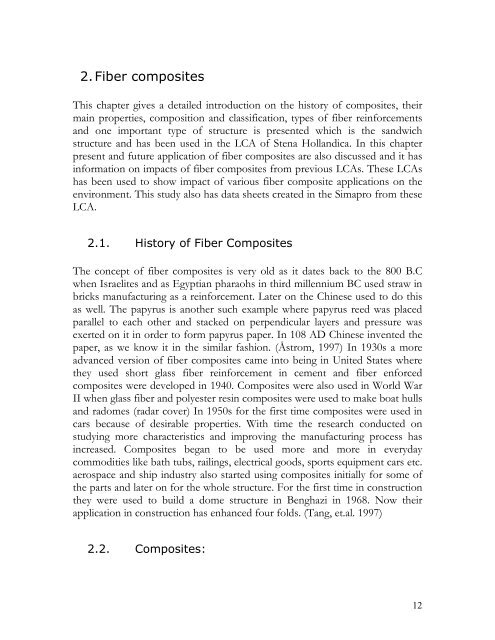Life Cycle Assessment of Fiber Composites_final__rättad
Life Cycle Assessment of Fiber Composites_final__rättad
Life Cycle Assessment of Fiber Composites_final__rättad
You also want an ePaper? Increase the reach of your titles
YUMPU automatically turns print PDFs into web optimized ePapers that Google loves.
2. <strong>Fiber</strong> composites<br />
This chapter gives a detailed introduction on the history <strong>of</strong> composites, their<br />
main properties, composition and classification, types <strong>of</strong> fiber reinforcements<br />
and one important type <strong>of</strong> structure is presented which is the sandwich<br />
structure and has been used in the LCA <strong>of</strong> Stena Hollandica. In this chapter<br />
present and future application <strong>of</strong> fiber composites are also discussed and it has<br />
information on impacts <strong>of</strong> fiber composites from previous LCAs. These LCAs<br />
has been used to show impact <strong>of</strong> various fiber composite applications on the<br />
environment. This study also has data sheets created in the Simapro from these<br />
LCA.<br />
2.1. History <strong>of</strong> <strong>Fiber</strong> <strong>Composites</strong><br />
The concept <strong>of</strong> fiber composites is very old as it dates back to the 800 B.C<br />
when Israelites and as Egyptian pharaohs in third millennium BC used straw in<br />
bricks manufacturing as a reinforcement. Later on the Chinese used to do this<br />
as well. The papyrus is another such example where papyrus reed was placed<br />
parallel to each other and stacked on perpendicular layers and pressure was<br />
exerted on it in order to form papyrus paper. In 108 AD Chinese invented the<br />
paper, as we know it in the similar fashion. (Åstrom, 1997) In 1930s a more<br />
advanced version <strong>of</strong> fiber composites came into being in United States where<br />
they used short glass fiber reinforcement in cement and fiber enforced<br />
composites were developed in 1940. <strong>Composites</strong> were also used in World War<br />
II when glass fiber and polyester resin composites were used to make boat hulls<br />
and radomes (radar cover) In 1950s for the first time composites were used in<br />
cars because <strong>of</strong> desirable properties. With time the research conducted on<br />
studying more characteristics and improving the manufacturing process has<br />
increased. <strong>Composites</strong> began to be used more and more in everyday<br />
commodities like bath tubs, railings, electrical goods, sports equipment cars etc.<br />
aerospace and ship industry also started using composites initially for some <strong>of</strong><br />
the parts and later on for the whole structure. For the first time in construction<br />
they were used to build a dome structure in Benghazi in 1968. Now their<br />
application in construction has enhanced four folds. (Tang, et.al. 1997)<br />
2.2. <strong>Composites</strong>:<br />
12
















